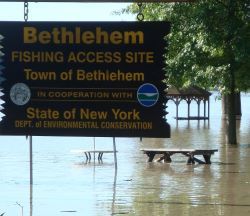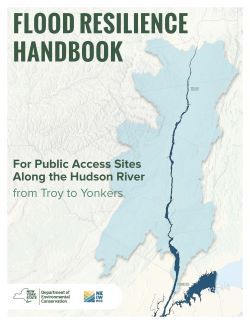Hudson Estuary Trees for Tribs Celebrates Arbor Day; Flood Resilience Handbook Now Available
The New York State Department of Environmental Conservation sent this bulletin on 04/27/2021 09:23 AM EDT |
| DEC Delivers - Information to keep you connected and informed from the NYS Department of Environmental Conservation |
| Share or view as a web page || Update preferences or unsubscribe |
Hudson RiverNet
|
In This Issue:
Hudson Estuary Trees for Tribs Pots-Up for Spring Planting Season
This spring will be one of the largest planting seasons for Hudson Estuary Trees for Tribs in nearly a decade. Staff and local volunteers will help plant more than 3,000 native trees and shrubs at 20 sites in nine counties this spring. One notable planting event will be at Shatford Municipal park in Columbia County. Through a collaboration with the Town of New Lebanon’s Conservation Advisory Council, volunteers will plant 520 trees and shrubs to create a new, 600-foot long, streamside forest along the Wyomanock Creek tributary. Trees planted along streams protect water quality, fish, and wildlife and also reduce erosion and flooding. Trees also absorb carbon dioxide from the atmosphere and are a powerful tool in the fight against climate change. Volunteers are welcome to join in the planting efforts. A list of public planting projects, volunteer opportunities, and contact information is available on DEC’s website. Volunteer planters are coordinated by local project managers at each site. Arbor Day is a nationally celebrated observance held on the last Friday of April each year. Originally established in 1872 to encourage farmers and homesteaders to plant trees for shade, fuel, and beauty in open areas, today Arbor Day is an opportunity to celebrate the vital role of trees in our lives.
Flood Resilience Handbook for Hudson River Public Access Sites
The handbook provides guidelines to begin planning for resilience, including strategies to reduce damage, costs, and other consequences associated with flooding and the effects of climate change. While many aspects of this handbook are relevant to river access sites elsewhere, the geographic focus is on the Hudson River estuary and its tidal tributaries in the 10 counties of the Hudson Valley: Albany, Columbia, Dutchess, Greene, Orange, Putnam, Rensselaer, Rockland, Ulster, and Westchester. Read the handbook on DEC's website. The Flood Resilience Handbook was produced by WSP with funding from NEIWPCC in partnership with DEC's Hudson River Estuary Program. |

 Hudson Estuary Trees for Tribs
Hudson Estuary Trees for Tribs
 More than 100 public access sites, including parks, preserves, boat launches, and fishing piers along the shores of the tidal Hudson provide outstanding recreational, scenic, and economic value to the Hudson Valley. However, climate models project the estuary’s water-levels may rise several feet by the end of this century, threatening the condition and viability of many of these shoreline facilities. Sea-level has risen six inches in the last 50 years, and today, low-lying sites regularly experience flooding during exceptionally high tides or periods of intense rainfall. Hurricane Irene, Tropical Storm Lee, Superstorm Sandy, and seasonal nor’easters destroyed infrastructure, caused erosion, and damaged recreational resources, and more frequent and intense storms are predicted to occur in the future.
More than 100 public access sites, including parks, preserves, boat launches, and fishing piers along the shores of the tidal Hudson provide outstanding recreational, scenic, and economic value to the Hudson Valley. However, climate models project the estuary’s water-levels may rise several feet by the end of this century, threatening the condition and viability of many of these shoreline facilities. Sea-level has risen six inches in the last 50 years, and today, low-lying sites regularly experience flooding during exceptionally high tides or periods of intense rainfall. Hurricane Irene, Tropical Storm Lee, Superstorm Sandy, and seasonal nor’easters destroyed infrastructure, caused erosion, and damaged recreational resources, and more frequent and intense storms are predicted to occur in the future. The
The